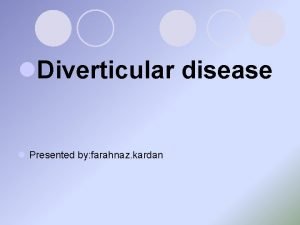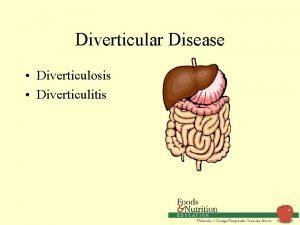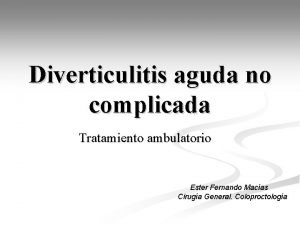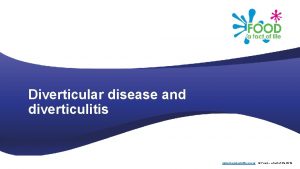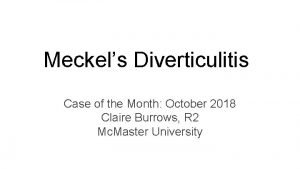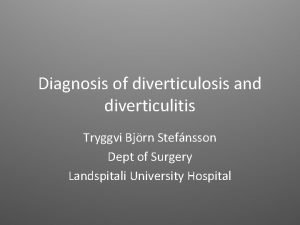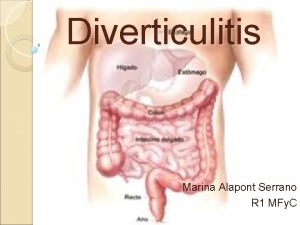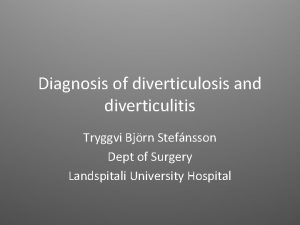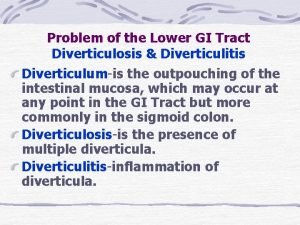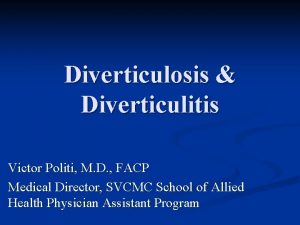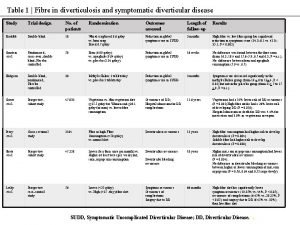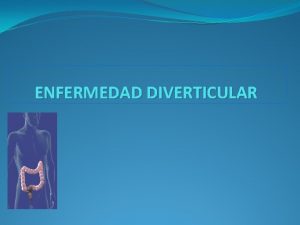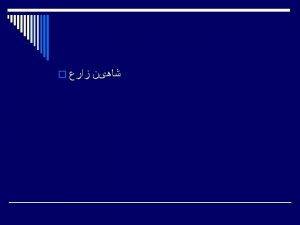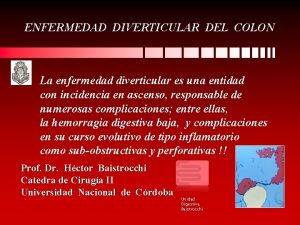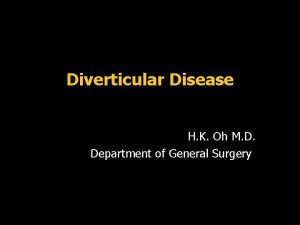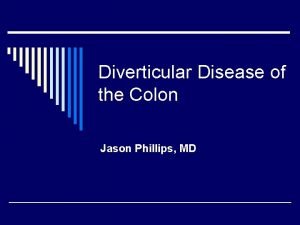Diverticular Disease Diverticulosis Diverticulitis Diverticulosis Common disease with














- Slides: 14

Diverticular Disease • Diverticulosis • Diverticulitis

Diverticulosis • Common disease with age • Cause unknown • Potential causes: – Constipation – Pressure caused by moving dry, hard bowel movements • Diverticula – pouch-like projections http: //digestive. niddk. nih. gov

Diverticulitis • Inflammation of the diverticula • Material caught in pocket causes inflammation, infection and bleeding.

Signs and Symptoms • Diverticulosis – Most people have no pain or symptoms – Diarrhea – Constipation – Flatulence – Heartburn

Signs and Symptoms • Diverticulitis – Tenderness – Cramps – Abdominal pain – Infection – Fever – Nausea, vomiting – Blood in the stool

How do you know if you have Diverticular Disease? • Ask your doctor • Knowing could prevent – Pain – Hospital stays • Get tested by your doctor

What causes Diverticular Disease? • Lack of fiber in diet – weak areas form pouches • Lack of exercise

Controlling Diverticulosis • Diverticulosis is different than diverticulitis – High fiber diet • Adds bulk and softens stools – Exercise or physical activity

Controlling Diverticulitis • • • Check with doctor first! Low fiber (residue) diet initially Gradually increase fiber Low fat diet In severe cases only – liquid diet or tube feeding may be necessary.

Follow a High Fiber Eating Plan • Eat more fruits, vegetables, whole grains and beans • Increase fiber gradually • Drink plenty of water

Should You Avoid Certain Foods? • Unknown at this time • Husks – Sunflower seeds – Peanuts • Popcorn • Fruit and vegetables with seeds

Be Physically Active • Important for colon health • 30 minutes most days of the week. – Divide into 5 to 10 minute sessions • Moderate intensity – Brisk walking, swimming, dancing, yard work, vacuuming, sweeping.

Points to Remember • Diverticular disease is a common disease that can develop with aging. • Lifestyle changes may help control diverticulosis and prevent diverticulitis. – Healthy eating – emphasizing a high fiber diet – Increase physical activity • If you experience signs and symptoms of diverticulitis consult your doctor.

Review 1. Which is the more severe form of diverticular disease, Diverticulosis or Diverticulitis? 2. Why is it important to eat a diet high in fiber to help control Diverticulosis? 3. What should you do first if you experience symptoms of Diverticulitis?
 Diverticulosis
Diverticulosis Diverticulitis symptoms
Diverticulitis symptoms Diverticulitis tratamiento farmacologico
Diverticulitis tratamiento farmacologico Esophageal diverticula
Esophageal diverticula Diverticulitis treatment diet
Diverticulitis treatment diet Uptodate
Uptodate Meckel diverticulum radiopedia
Meckel diverticulum radiopedia Microorganis
Microorganis Tryggvi björn stefánsson
Tryggvi björn stefánsson Diverticulitis
Diverticulitis Communicable disease and non communicable disease
Communicable disease and non communicable disease Common anode and common cathode
Common anode and common cathode Hcf 60 and 72
Hcf 60 and 72 Factors of 42
Factors of 42 Lowest common factor
Lowest common factor
